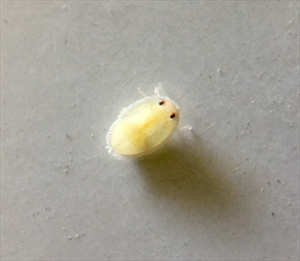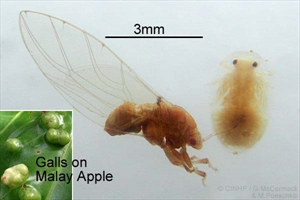Leaf gall psyllid, Eugenia psyllid, Malay apple gall psyllid, rose apple psyllid. Psyllids are often referred to as 'jumping lice'.
Pacific Pests, Pathogens, Weeds & Pesticides - Online edition
Pacific Pests, Pathogens, Weeds & Pesticides
Malay apple gall psyllid (366)
Trioza vitiensis; previously, known as Metatrioza vitiensis.
South and Southeast Asia (Sri Lanka, Malaysia, Singapore), Oceania. It is recorded from Federated States of Micronesia, Fiji, French Polynesia, Palau, and Samoa.
Malay apple, Syzigium (Eugenia) malaccense.
The nymphs suck the contents of cells of the leaf and this causes them to develop galls. The adults do not cause gall formation.
Females lay their eggs on the new leaves and shoots. The nymphs crawl to the underside of the leaves where they feed by sucking sap, and at the same time injecting saliva. This leads to the formation of a small hollow pit on the underside of the leaf with a nymph inside. Rounded galls appear on the upper surface of the leaf (Photos 1-4), and the pits form galls too, enclosing the nymphs in a protruding 'cup' (Photo 5). Finally, the galls on the lower surface split and the adults emerge (Photo 6).
The nymphs are clear, flat, have prominent eyes, and a fringe of white short hairs around the body (Photo 7). They go through several moults before the gall splits and the adult emerges.
Adults are light brown, 2 mm long, with clear wings and noticeable veins (Photo 8).
The reasons why this and other psyllids form galls is not known, but suggestions are to avoid parasitoids and predators, protection against the environment, particularly to avoid desiccation, or to obtain beneficial nutrient-rich foods from cells that have been stimulated to grow actively.
Spread of the psyllid is thought to occur by wind or ocean currents. It has even been suggested that spread occurs in the galls. In the Hawaiian Islands, many of the psyllids belong to the Trioza family and form galls. The idea is that these remote islands were colonised by a few of these insects arriving on wind and/or ocean currents and subsequently diversified into many types. Psyllids within the galls might be more successful in being transported these ways compared to their free-living relatives. Not all entomologists agree as some species that do not form galls are also widely dispersed.
Large numbers of galls often occur on mature trees (Photo 4), but it appears unlikely that they reduce the life-span of the leaves, rate of growth of the trees or the yield of fruit. Greatest impact seems to be on seedlings, but studies on impact are not reported from Pacific island countries. If there is an impact, it is more likely to be because of the disfigured foliage rather than impact on fruit bearing, especially if the trees are used as ornamentals.
Look for the galls, which are obvious and characteristic of this psyllid species on Malay (rose) apple. Cut the galls to find the nymphs and adults.
NATURAL EMEMIES
There is a wide range of potential predators that prey on psyllids, including lacewing larvae and ladybird beetle larvae and adults. Parasitoid, Tamarixia species, are active against this psyllid.
CULTURAL CONTROL
Prune plants in nurseries, or used as hedges followed by pesticide application to new growth(see below). Similar treatment is recommended for Malay (rose) apple trees used as ornamentals. In other situations, it is unlikely to be beneficial either in terms of appearance of the trees or of economic return.
CHEMCIAL CONTROL
If a pesticide is needed after pruning and when new growth appears, use a synthetic pyrethroid insecticides, such as lambda cyhalothrin or permethrin; malathion is also a possibility. The latter has been suggested for control of Trioza eugeniae on Syzigium species in Australia.
The aim when using any of these pesticides is to protect new foliage from infestation; spraying already infested growth will be unsuccessful as the psyllid is protected by being inside the galls. The choice of chemical is important: use those that are least persistent in the environment, and have low toxicity against bees; the use of imidacloprid is not recommended (unless used outside time of flowering).
____________________
When using a pesticide, always wear protective clothing and follow the instructions on the product label, such as dosage, timing of application, and pre-harvest interval. Recommendations will vary with the crop and system of cultivation. Expert advice on the most appropriate pesticide to use should always be sought from local agricultural authorities.
AUTHOR Grahame Jackson & Mani Mua
Information from Hodkinson ID The biology and ecology of the gall-forming Psylloidea (Homoptera). In: TN Ananthakrishnan Biology of gall insects. Oxford University Press. (https://www.researchgate.net/publication/270284681_The_biology_and_ecology_of_the_gall-forming_Psylloidea_Homoptera); and Au S (2013) Succession in galls on Syzygium malaccense and their impact on leaf aging. UC Berkeley. (https://cloudfront.escholarship.org/dist/prd/content/qt847704sb/qt847704sb.pdf); and from Swaine G (1971) Agricultural Zoology in Fiji. Her Majesty's Stationery Office. London. Photos 3&8 Gerald McCormack & Maja Poeschko, Cook Islands Biodiversity & Natural Heritage. (http://cookislands.bishopmuseum.org/).
Produced with support from the Australian Centre for International Agricultural Research under project HORT/2016/185: Responding to emerging pest and disease threats to horticulture in the Pacific islands, implemented by the University of Queensland and the Secretariat of the Pacific Community.











